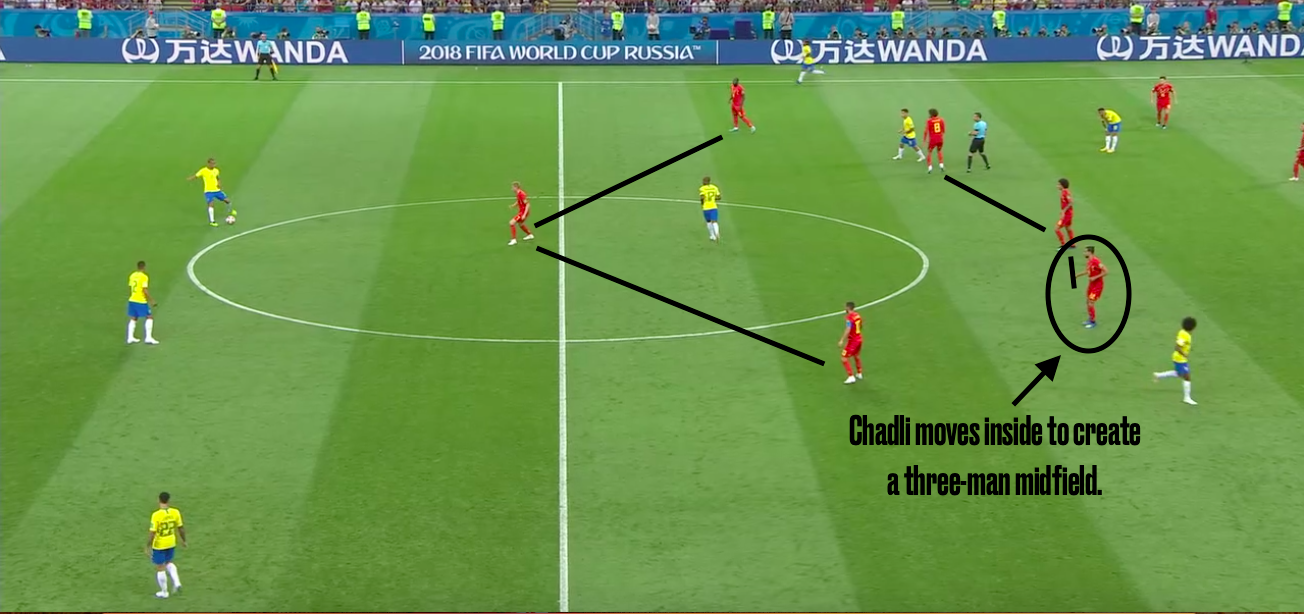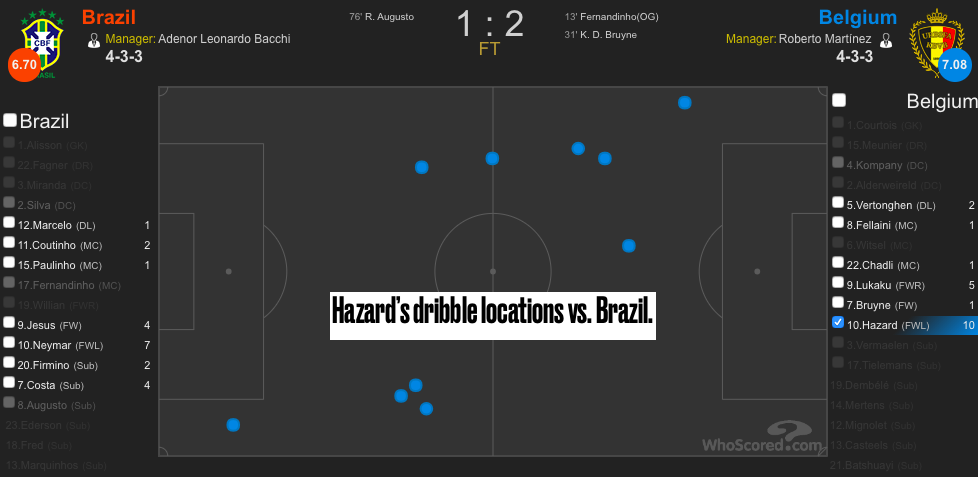Om Arvind is back at it, writing out a tactical analysis of the World Cup quarter final that ended Brazil 1-2 Belgium.
Brazil entered the 2018 World Cup as one of the favorites thanks to their athletic and/or defensively astute central midfielders Casemiro, Paulinho, and Fernandinho, and the fearsome left-sided trio of Marcelo, Coutinho, and Neymar. Understanding the threat the latter threesome posed, Belgium manager Roberto Martínez instructed his side to overload the right section of their midfield. This ploy forced the three tricksters to play through clogged spaces or switch play to the under-supported Willian. Eventually, the difficulty of building these types of attacks led to losses of possession that Belgium looked to convert into dangerous counter-attacks; Hazard and Lukaku led the way in this department with their dribbling, hold-up play, and aerial duels. This strategy, along with a handy own goal, provided Belgium with a two-goal cushion – something they held onto for dear life as Tite’s second half adjustments allowed Brazil to created chance after chance in a valiant losing effort.
Lineups:
Belgium (5-3-2/5-2-1-2): Courtois // Meunier – Alderweireld – Kompany – Vertonghen – Chadli (Vermaelen, 83’) // Fellaini – Witsel – De Bruyne // Lukaku (Tielemans, 87’) – Hazard
Brazil (4-3-3): Alisson // Fagner – Silva – Miranda – Marcelo // Paulinho (Augusto, 73’) – Fernandinho – Coutinho // Willian (Firmino, 46’) – Jesus (Costa, 58’) – Neymar
Belgium’s Conservative Approach & Defensive Structure
Belgium’s victory was aided by Martínez’s decision to employ a counter-attacking game, something he probably did to mitigate his side’s poor transitional defense. This was achieved by forgoing a high press to sit in a medium block, thereby allowing Brazil to easily progress the ball from the defensive third to the middle third of the pitch. Belgium’s mid-block shape was a 4-3-3, with Nacer Chadli tucking into midfield from his left-wing back position and Jan Vertonghen turning into a left back.

Hazard, De Bruyne, and Lukaku positioned themselves in ways to prevent passes through the center, while Chadli and Fellaini man-marked Paulinho and Coutinho respectively and Witsel provided vertical compactness. Though this could’ve proved to be a robust structure that prevented Brazil access to the final third, the front three defended passively and allowed the opposition to progress play through rotational shifts that eventually targeted the flanks. It was only after Brazil got near the box that Belgium’s defensive shape sprang into action, as the luxury of an extra midfielder allowed Martínez’s side to compress their structure and overload their right flank.
As can be seen above, this structure occurred when De Bruyne dropped deep to create a 4-3-1-2 deep block in order to fashion a 4v3 against Neymar, Coutinho, and Marcelo. Witsel and Fellaini joined De Bruyne in this endeavor, while Nacer Chadli kept a degree of horizontal compactness by sticking close to Paulinho and guarding against passes into zone 14.
This scheme made life extremely difficult for Brazil in the first half, as Tite’s men have always relied heavily on their left-sided combinations to break down opposing deep blocks. While the dynamic trio did their best to play through a sea of players and enter the box through quick one-twos, Belgium generally repelled their attacks and limited Brazil to low-quality open play opportunities (Brazil’s only real chance of the half came via a corner kick in the 8th minute).
Belgium’s Attacking Play & Focus on Transitions
When in possession, Belgium structured themselves in a 5-3-2/5-2-1-2, with Chadli shifting out wide to a left wing-back position and De Bruyne acting as an advanced playmaker in the left half space. But thanks to Martínez’s conservative tactics and Brazil’s high pressing, they rarely fashioned chances from these situations and were instead limited to finding scoring opportunities on the counter-attack.
Belgium chose to direct their transition moments through two main checkpoints: Romelu Lukaku down the right and Eden Hazard down the left. Both players contested for clearances and long passes in the air (Hazard surprisingly won more aerial duels; 4 to Lukaku’s 2) and either held up play or dribbled past pressers to start an attack. Lukaku was instrumental in the early going and ended up sparking the counter-attack that resulted in the winning goal.
As Miranda grew into the game and began to better handle the threat of Lukaku, Hazard became the main outlet responsible for giving his team a breather and creating offensive opportunities. Luckily for Belgium, Hazard thrived in such a situation, completing an otherworldly 10/10 dribbles and drawing 7 fouls in a man of the match-worthy performance.

However, Belgium’s success on the break was also partly down to Paulinho’s advanced positioning. Due to the midfielder’s subpar link-play ability and his above average threat in the box, he was almost always positioned on the edge of the area in order to capitalize on potential dangerous deliveries. Unfortunately for him, those moments never arrived, making his positioning a big net negative as Belgium countered into the large hole he left behind in the right half space.
Tite’s Substitutions & Second Half Adjustments
The seemingly obvious solution to Brazil’s left-sided reliance would’ve been to switch the point of attack to the right flank, but Brazil did not have the right personnel on the field in the first half to make that a viable solution. As mentioned before, while Paulinho is useful defensively and a significant goal threat with his late runs into the box, he does not provide much in regards to incisive passing and combination play. Additionally, Fagner, for whatever reason, hardly ventured forward to provide attacking width and runs down the overlap, leaving Willian in difficult 1v1 and 1v2 situations.

Paulinho and Fagner received the vast majority of their touches in deep positions, representing the lack of support they provided Willian down the right flank
Tite immediately sought to rectify this issue after half-time break by bringing on Roberto Firmino for Willian (this shifted Gabriel Jesus out to the right-wing until he was replaced by Douglas Costa in the 58th minute). Firmino immediately proved superior to Jesus due to the former’s willingness to drop in-between the lines to latch onto vertical passes and his propensity to sit in zone 14. The latter quality helped to add another man to Brazil’s combination play and also made it easier to facilitate play to the right-hand side of the pitch. Nevertheless, Belgium’s compact defensive structure managed to deal with these specific threats fairly well, meaning the striker made his biggest impact when he drifted to the right-wing and acted as the fulcrum of counter-attacks.
Douglas Costa also proved to be big difference-maker, as his pace and 1v1 ability allowed him to cut inside to switch play, create for others, or shoot on goal even if he didn’t have proper support from a central midfielder or a fullback (he managed 4 shots – 3 of which found its way on target – 2 key passes, and 3 dribbles in 32 minutes).
With the aforementioned duo providing different and more effective tactical options than their predecessors, it is perhaps ironic that the goal scorer was substitute Renato Augusto, a player who replicated Paulinho’s role exactly – a right interior who makes late runs into the box.
Tite melded these changes with a more diversified attacking approach that saw Brazil utilize the right-wing more frequently. This was not only aided by the presence of Firmino and Douglas Costa, but also by Neymar and Coutinho, who sought to roam infield more often in order to connect with teammates on the other side of the pitch. These adjustments allowed for more swift side-to-side movements, destabilizing Belgium’s defensive structure and exploiting the lack of width in their 4-1-3-2 shape. At a simpler level, Brazil’s players simply expanded their vision and became more aware of movements down the right, allowing for neat long passes that put Gabriel Jesus and Douglas Costa in threatening situations.
Conclusion
Despite Tite’s positive changes in the second half, Brazil failed to force extra time thanks to a heroic performance from Thibaut Courtois and moments of poor finishing from Brazil. Tite will probably wonder why he didn’t tackle his team’s one-dimensionality in attack prior to the game, but he can still walk away from this result proud of the way he reacted to things after the first half.
One must also wonder whether the suspended Casemiro would’ve made a difference, given his unparalleled ability to single-handedly stop counter-attacks (something that he has gained immense experience with at Real Madrid). One might argue that his pace, defensive intelligence, and ball-winning ability would’ve been enough to deal with Lukaku and cover for Paulinho’s advanced positioning.
Like Tite, Roberto Martínez also has reason to be pleased with himself, given the way he adjusted his midfield to suffocate Brazil’s main strength. However, his team did not have an answer to Tite’s Plan B and Martínez should consider himself rather fortunate to be progressing to the semifinals all things considered.

Read all our tactical analyses here.
- Tactical Analysis: Brazil 1-2 Belgium | Belgium Nick a Fortunate Win Through Decisive Counter-Attacks - July 8, 2018
- Tactical Analysis: Real Madrid 0-3 Barcelona | Los Blancos Implode in the 2nd Half - December 28, 2017
- Tactical Analysis: Girona 2-1 Real Madrid | Girona’s Pressing Hassles Los Blancos - October 31, 2017
























































